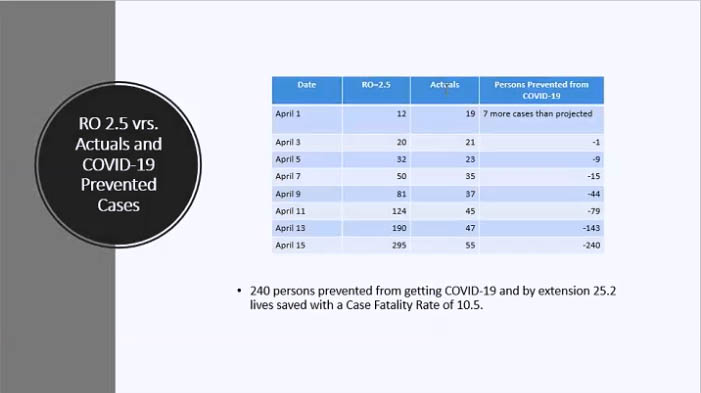The second largest daily increase in positive novel coronavirus disease (COVID-19) cases here was recorded yesterday even as Pan American Health Organization (PAHO) representative Dr William Adu-Krow said that the curve was slowly being flattened.
Yesterday, it was disclosed that the number of positive COVID-19 cases in Guyana has increased by six, bringing the total to 63 after 23 more persons were tested. The number represents the second largest increase in the number of positive cases since the first case of COVID-19 was recorded in Guyana on March 11th. The number of cases slowly crawled upwards until March 31st when there was a spike and positive diagnoses rose by seven. On April 15th, the number of cases spiked by seven again bringing the total to 55 confirmed cases. The total now stands at 63 COVID-19 cases.
During an update by Minister of Public Health Volda Lawrence yesterday, it was disclosed that the number of cases is inclusive of six deaths, while a total of 283 persons have been tested so far for the disease since testing began in late February.
The minister also observed that some 220 persons have tested negative for the disease while nine persons have recovered thus far. Fifteen persons are now in institutional quarantine while 48 are in institutional isolation and four persons are in the COVID-19 Intensive Care Unit (ICU).
Lawrence pointed out that the number of cases is rising rapidly as she highlighted that 18 cases have so far been recorded for this week.
Specifically, it was mentioned that the number of confirmed cases in Region Four represent 87.7% of the overall cases, with the majority originating from Georgetown. Out of the current 63 recorded cases, four are imported cases while the other 59 contracted the disease through local transmission.
Meanwhile, during a virtual press conference yesterday, Dr Adu-Krow, while displaying charts based on PAHO’s projections and in comparison with world numbers, said that so far, Guyana’s curve has been flattening. According to the official, based on the measures instituted like the nationwide curfew, “the curve” in relation to the spread of the virus is slowly being flattened.
“If the measures stay, you will realise that we are beginning to flatten the curve,” Dr Adu-Krow said. According to the PAHO representative, at the start of the recording of cases in Guyana, the projected rate of reproduction stood at 2.5 and the number of cases would have been significantly higher if restrictions were not in place.
However, with restrictions, the current number of cases, and the projected rate of reproduction lowered to 1.5, he said, the number of cases would not rise significantly.
Nevertheless, “if at May 1st, the government relaxes the curfew and everything… it begins an exponential rise…We will be getting about 5,000 cases in no time,” he warned.
Dr Adu-Krow emphasised that the situation needs to be taken more seriously and said that it is not time to lift the restrictions that are in place and added that they should be further enforced.
The PAHO representative also provided projections of figures if no restrictions were in place. “By April 5th, the number of cases projected were 32 but we had 23 so it means nine persons were prevented from getting COVID because of measures that have been taken,” he said.
Furthermore, Dr Adu-Krow noted that in other countries, if 100 cases are recorded, two to four of those persons die as a result of the virus. However, in Guyana, that number could be projected as 10.5 persons dying as a result of the virus. In addition, he mentioned that the test positivity rate stands at 21.5%.
Meanwhile, he stated that according to the World Health Organization (WHO), there are certain guidelines that should be followed before restrictions or curfews are lifted. It was stated that the curfew should be lifted only if transmission is controlled, importation risks can be managed and if health system capacities are in place to detect, test, isolate and treat every case and trace every contact. It was also stated that the curfew should only be lifted if preventative measures are implemented in social settings such as workplaces and schools and if communities are fully educated, engaged and empowered to adjust to “the new norm.”
Two weeks ago, PAHO/WHO had announced that following evaluations, the number of projected COVID-19 cases in Guyana could reach as much as 20,000 by May 5th. At that time, Adu-Krow told members of the media that if Guyanese don’t begin acting differently, including practicing more stringent physical distancing, the number of cases will continue to rise rapidly. Further, he said that the country’s health care system would not be able to handle the number of cases projected.

